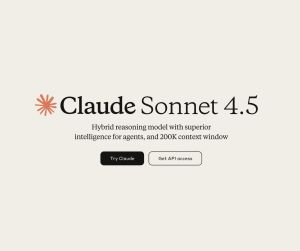Claude Sonnet 4.5 introduces smarter AI tools with stronger memory, smoother speed, and new possibilities for businesses and creators.
Artificial intelligence is moving fast, but every so often, a release captures attention because it feels different. Claude Sonnet 4.5, the latest model from Anthropic, is one of those releases. It is being described as the world’s most capable AI coding model, but the excitement goes far beyond developers. What makes this moment important is how much closer AI is starting to feel like a true partner at work rather than just a handy tool.
What Makes Claude 4.5 Stand Out
Claude is Anthropic’s family of AI models, trained to read, write, and code. The Sonnet line is designed to balance power with accessibility, and version 4.5 represents a noticeable leap forward.The biggest change is stamina. Earlier AI tools often struggled to stay on track for long tasks. Claude 4.5 has been tested to keep coding for close to thirty hours without losing its thread. That endurance makes it possible to hand off a complex project and come back later to find it still progressing smoothly.
It is also more capable of interacting with computer systems. Instead of needing constant guidance, it can open files, navigate environments, and adjust code with less supervision. Combined with improvements in reasoning across subjects like finance and science, this model feels less like a chatbot and more like a dependable teammate who can handle the detail work.
How People Are Using It
In practical terms, Claude Sonnet 4.5 is showing up in familiar places such as GitHub Copilot, which means developers can access it directly in their workflow. Businesses experimenting with autonomous “agents” are also starting to use them for background tasks like monitoring systems or processing information step by step.It can review code for errors, explain complex ideas in simpler terms, and take on repetitive tasks that usually slow down teams. That combination of focus and patience gives people more time to concentrate on strategy and creative problem-solving.
Why It Still Needs a Human Touch
Even with these improvements, Claude 4.5 is not flawless. It can misunderstand unclear instructions or stumble on unusual problems. The model works best with human guidance, which is why the real power lies in collaboration.Think of it as an exceptionally dedicated intern. It can work for long hours, process vast amounts of information, and deliver clean drafts, but it still relies on people for direction, judgment, and context. The partnership between human creativity and AI stamina is where real breakthroughs happen.
What This Means for Business Leaders
For companies, the rise of models like Claude Sonnet 4.5 signals a shift in how work gets done. Instead of pouring time and energy into repetitive or technical details, teams can delegate those steps to AI and focus on innovation, growth, and relationships.This isn’t about replacing staff. It is about giving them better support. Businesses that learn how to integrate AI into everyday operations will move faster and with less friction, while those who hesitate may find competitors pulling ahead with new efficiencies.
The Bigger Picture
Claude Sonnet 4.5 is an early glimpse of where AI is heading. Models are becoming more persistent, more reliable, and more useful in practical settings. What once felt like an experiment now feels like a foundation for how teams may work in the near future.
How Interactive Partners Can Help
At Interactive Partners, we help businesses make sense of these shifts. Tools like Claude Sonnet 4.5 are powerful, but their value depends on how they are applied. We work with teams to design smart workflows, build safe integrations, and make sure technology supports real goals.If you want to explore how AI could become a genuine teammate for your business, let’s talk! Together, we can turn this breakthrough into meaningful results.
Share this post
Subscribe to get exclusive content
Connect with Us
Are you ready to partner with a team committed to turning your business challenges into opportunities? Let’s build something extraordinary together!
